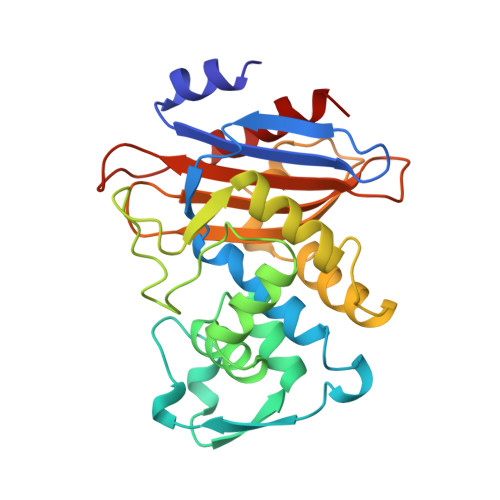Relocation of the catalytic carboxylate group in class A beta-lactamase: the structure and function of the mutant enzyme Glu166-->Gln:Asn170-->Asp.
Chen, C.C., Herzberg, O.(1999) Protein Eng 12: 573-579
- PubMed: 10436083
- DOI: https://doi.org/10.1093/protein/12.7.573
- Primary Citation of Related Structures:
1KGG - PubMed Abstract:
The hydrolysis of beta-lactam antibiotics by the serine-beta-lactamases proceeds via an acyl-enzyme intermediate. In the class A enzymes, a key catalytic residue, Glu166, activates a water molecule for nucleophilic attack on the acyl-enzyme intermediate. The active site architecture raises the possibility that the location of the catalytic carboxylate group may be shifted while still maintaining close proximity to the hydrolytic water molecule. A double mutant of the Staphylococcus aureus PC1 beta-lactamase, E166Q:N170D, was produced, with the carboxylate group shifted to position 170 of the polypeptide chain. A mutant protein, E166Q, without a carboxylate group and with abolished deacylation, was produced as a control. The kinetics of the two mutant proteins have been analyzed and the crystal structure of the double mutant protein has been determined. The kinetic data confirmed that deacylation was restored in E166Q:N170D beta-lactamase, albeit not to the level of the wild-type enzyme. In addition, the kinetics of the double mutant enzyme follows progressive inactivation, characterized by initial fast rates and final slower rates. The addition of ammonium sulfate increases the size of the initial burst, consistent with stabilization of the active form of the enzyme by salt. The crystal structure reveals that the overall fold of the E166Q:N170D enzyme is similar to that of native beta-lactamase. However, high crystallographic temperature factors are associated with the ohm-loop region and some of the side chains, including Asp170, are partially or completely disordered. The structure provides a rationale for the progressive inactivation of the Asp170-containing mutant, suggesting that the flexible ohm-loop may be readily perturbed by the substrate such that Asp170's carboxylate group is not always poised to facilitate hydrolysis.
Organizational Affiliation:
Center for Advanced Research in Biotechnology, University of Maryland Biotechnology Institute, 9600 Gudelsky Drive, Rockville, MD 20850, USA.















